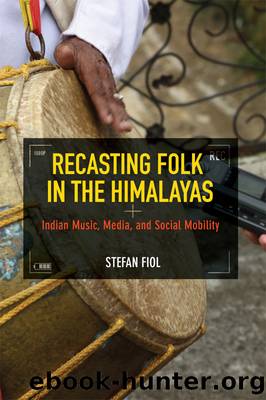Recasting Folk in the Himalayas by Fiol Stefan;

Author:Fiol, Stefan;
Language: eng
Format: epub
Publisher: University of Illinois Press
Published: 2017-10-14T16:00:00+00:00
Fig. 4.2. Sohan Lalâs ensemble Himalaya Nad, undated (courtesy S. Fiol)
After the Virasat performance, members of the group had been instructed to return to their villages to start their own folk ensembles. Several groups were successfully launched through this initiative, and some received financial support to purchase costumes. At present, however, Sohan Lalâs group is the only one spawned by the REACH workshop that continues to perform. It is clear that he absorbed much from his participation in Himalaya Nad. In fact, Lal adopted the same name for his own group, which performs extensively throughout Uttarakhand and in migrant communities in other parts of India for diverse occasions including weddings, birthday celebrations, regional and national festivals, healing rituals (jagar), and receptions at the airport for arriving political figures. His group currently consists of about thirty-five members of his extended family; during the wedding season Lal divides the troupe into three or four smaller groups in order to maximize income-earning opportunities. Depending on the budget of the client and the requirements of the occasion, Lal gathers a team of four to twelve performers, all attired in blue kurtas with white pajamas and Pahari caps (figure 4.2). In addition to the standard instrumentation of the Pahari hill band (dhol, damaun, and mashakbin), Sohan Lal uses the double-reed shehnai (played by the bagpiper, who attaches a reed to the chanter), a set of natural horns (the ransingha and the bhankora, also called the turi), and a Casio keyboard with a portable amplifier. His groups are invited to perform for urban and rural audiences from diverse backgrounds; consequently, they have prepared a range of commercial Garhwali, Jaunsari, Kumaoni, and Hindi film songs, as well as local items that traditionally would be performed by the Bajgi community. During weddings, for instance, Lalâs group performs processional rhythms during the barat, and it performs rhythms of invocation (barhai) and auspicious songs (mangal geet) during important moments of the ritual; at other times, however, the group accepts requests for commercial songs or plays a range of local hits to encourage people to dance.
Download
This site does not store any files on its server. We only index and link to content provided by other sites. Please contact the content providers to delete copyright contents if any and email us, we'll remove relevant links or contents immediately.
| Anthropology | Archaeology |
| Philosophy | Politics & Government |
| Social Sciences | Sociology |
| Women's Studies |
The Leavers by Lisa Ko(6471)
Born to Run: by Christopher McDougall(6259)
iGen by Jean M. Twenge(4702)
Sapiens by Yuval Noah Harari(4534)
The Kite Runner by Khaled Hosseini(4430)
Spare by Prince Harry The Duke of Sussex(4195)
Bullshit Jobs by David Graeber(3179)
Livewired by David Eagleman(3121)
Goodbye Paradise(2958)
Never by Ken Follett(2879)
A Dictionary of Sociology by Unknown(2517)
Harry Potter 4 - Harry Potter and The Goblet of Fire by J.K.Rowling(2416)
The Club by A.L. Brooks(2357)
People of the Earth: An Introduction to World Prehistory by Dr. Brian Fagan & Nadia Durrani(2346)
The Social Psychology of Inequality by Unknown(2309)
Machine Learning at Scale with H2O by Gregory Keys | David Whiting(2285)
Harry Potter and the Order of the Phoenix (5) by J.K. Rowling(2226)
0041152001443424520 .pdf by Unknown(2219)
Don't Sleep, There Are Snakes by Daniel L. Everett(2216)
